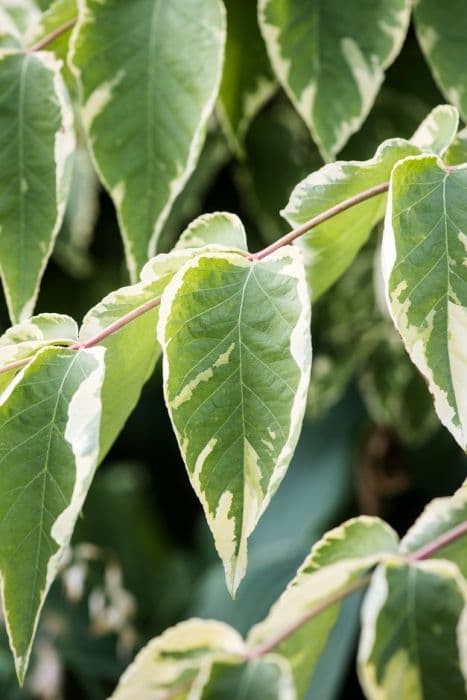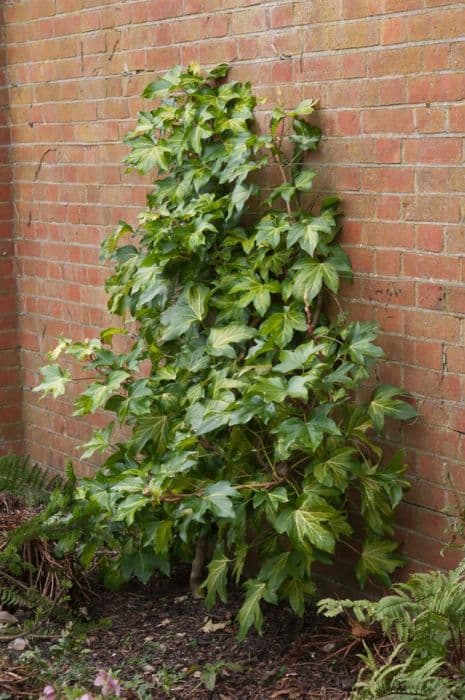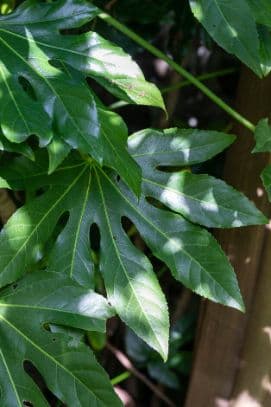Tree ivy × Fatshedera lizei 'Variegata' (v)

ABOUT
The plant commonly known as variegated tree ivy, is a unique and visually striking hybrid. It is an intergeneric cross that marries characteristics from its parent plants, resulting in a singular foliage display. The leaves of variegated tree ivy are its most distinctive feature; they are large, glossy, and palmately lobed, resembling those of an ivy. Each leaf showcases a beautiful mosaic of green painted with creamy white or yellowish streaks and margins, giving the foliage a variegated appearance. These splashes of color sometimes form patterns that can be quite dramatic, offering visual interest throughout the year. As the common name suggests, variegated tree ivy has a vining habit, often producing long stems that can be trained to climb or allowed to trail, depending on how it is maintained. It can also be grown as a shrub with some support. The stems carry the striking leaves and can be both sprawling and arching, adding to the plant's versatility in a garden setting or as an indoor specimen. The flowers of variegated tree ivy are less significant compared to its foliage and are not commonly mentioned among its ornamental traits. The inflorescence is relatively inconspicuous, so the plant is primarily cultivated for its attractive leaves. The variegation on the leaves of variegated tree ivy tends to be stable, ensuring a consistent display of the lighter markings that make it so appealing for both landscapers and houseplant enthusiasts.
About this plant
 Names
NamesFamily
Araliaceae.
Synonyms
Variegated Tree Ivy, Variegated Aralia Ivy, Variegated Botanical Wonder, Variegated Fatshedera.
Common names
× Fatshedera lizei 'Variegata' (v)
 Toxicity
ToxicityTo humans
The plant known as tree ivy (× Fatshedera lizei 'Variegata') is considered to be mildly toxic to humans. If ingested, the leaves of this hybrid plant can cause discomfort in the mouth, including a burning sensation, irritation of the lips, tongue, and throat, excessive drooling, and difficulty swallowing. In some cases, it may also cause gastrointestinal upset, such as nausea, vomiting, or diarrhea. Any part of the tree ivy, if eaten in significant quantities, could potentially lead to these symptoms, so it is advisable for humans to avoid consuming this plant.
To pets
Tree ivy (× Fatshedera lizei 'Variegata') is also mildly toxic to pets, including dogs and cats. If a pet ingests this plant, it may experience symptoms similar to those in humans, such as mouth irritation, drooling, vomiting, and diarrhea. Ingestion of this plant can lead to gastrointestinal distress and potentially an aversion to eating due to the discomfort it causes. As with humans, pets should not ingest any part of the tree ivy plant. If you suspect your pet has ingested this plant, it is advisable to contact a veterinarian.
 Characteristics
CharacteristicsLife cycle
Perennials
Foliage type
Evergreen
Color of leaves
Variegated
Height
5 feet (1.5 meters)
Spread
4 feet (1.2 meters)
Plant type
Shrub
Hardiness zones
8
Native area
Hybrid
Benefits
 General Benefits
General Benefits- Easy to Grow: 'Variegata' is known for being low maintenance and relatively easy to care for, which is ideal for novice gardeners.
- Variegated Foliage: The plant offers aesthetic appeal with its variegated leaves that add visual interest to garden spaces.
- Versatility: This hybrid can be used in various garden settings, including borders, containers, or as a climber with support.
- Drought Tolerance: Once established, it has a degree of drought tolerance, making it suitable for xeriscaping or regions with less rainfall.
- Pest Resistance: It has a natural resistance to common garden pests, reducing the need for chemical treatments.
- Fast-Growing: This plant can grow quite rapidly, providing quick coverage or filling in garden spaces in short periods of time.
 Medical Properties
Medical PropertiesThis plant is not used for medical purposes.
 Air-purifying Qualities
Air-purifying QualitiesThis plant is not specifically known for air purifying qualities.
 Other Uses
Other Uses- × Fatshedera lizei 'Variegata' (v), commonly known as Aralia Ivy, can be trained as a topiary, shaping it into geometric forms or animal figures that add a unique touch to gardens and landscape designs.
- The plant’s variegated leaves provide a striking contrast when used in floral arrangements or as a decorative piece in bridal bouquets.
- Aralia Ivy's robust and adaptive nature makes it suitable for creating living green screens or privacy hedges in urban and suburban environments.
- The vine-like growth habit of Aralia Ivy allows it to be used as a living curtain when grown on trellises, providing shade and cooler areas during hot weather.
- Its hardiness and interesting foliage pattern make it a fascinating subject for botanical illustration and plant photography, being a popular choice for workshops and classes.
- The ease of propagation through cuttings means Aralia Ivy can be shared among gardeners and used in plant swap events, fostering community and gardening interest.
- Incorporating Aralia Ivy into mixed container gardens can add texture and variegation, complementing other plants and enhancing the overall visual appeal.
- Using the plant as ground cover in shaded areas can help to suppress weeds and reduce garden maintenance requirements.
- This hybrid can be used in educational settings such as schools and botanical gardens to demonstrate plant hybridization and the effects of variegation.
- Cultivating Aralia Ivy indoors can bring a touch of the outdoors inside, which is especially beneficial for individuals living in apartments or homes without gardens.
Interesting Facts
 Feng Shui
Feng ShuiThe Tree Ivy is not used in Feng Shui practice.
 Zodiac Sign Compitability
Zodiac Sign CompitabilityThe Tree Ivy is not used in astrology practice.
 Plant Symbolism
Plant Symbolism- Adaptability: The × Fatshedera lizei 'Variegata', commonly known as 'Tree Ivy' or 'Botanical Wonder', is a hybrid plant, symbolizing the ability to adapt well to different environments, as it blends the characteristics of two species.
- Versatility: Being part arboreal and part ground-dwelling in nature, Tree Ivy symbolizes versatility and flexibility, able to thrive in various conditions and situations.
- Beauty in Diversity: The variegated leaves of the Tree Ivy represent the beauty found in diversity and mixed heritage, illustrating how different traits come together to create something unique and aesthetically pleasing.
- Persistence: Tree Ivy's growth habit can be an emblem of persistence, as it will continue to grow and climb, reflecting determination and steady progress.
 Water
WaterThe Tree Ivy should be watered when the top inch of soil feels dry to the touch. It's typically best to water this plant deeply but infrequently, which might average out to about once a week, although this can vary depending on environmental conditions. When watering, add water slowly until it begins to drain out of the bottom of the pot, indicating the soil has been thoroughly saturated. Avoid letting the plant sit in standing water. Over the course of a month, a Tree Ivy in a standard indoor setting may need around 2 gallons of water, but always adjust based on the plant's response and the moisture level of the soil.
 Light
LightTree Ivy thrives in bright, indirect light but can tolerate some shade. Avoid direct sunlight, as this can scorch the leaves. A spot near a window that receives filtered light or a place that gets morning or late afternoon sun would be ideal. The variegation on the leaves may become more pronounced with adequate light exposure.
 Temperature
TemperatureTree Ivy prefers temperatures between 60 and 75 degrees Fahrenheit but can tolerate a range from 50 to 80 degrees Fahrenheit. It should not be exposed to temperatures below 50 degrees Fahrenheit as it could lead to cold damage. The ideal temperature for this plant is typical indoor room temperature, making it well-suited for indoor cultivation.
 Pruning
PruningPrune Tree Ivy to maintain its shape and encourage a bushier growth habit. The best time for pruning is in the spring before new growth begins. Pruning can be done as often as needed to remove dead or yellow leaves and to keep the plant looking tidy. Use sharp, clean shears to make cuts just above leaf nodes.
 Cleaning
CleaningAs needed
 Soil
SoilTree ivy requires well-draining soil with a peat-based or loamy component and good organic matter content. The best soil mix is one part peat, one part pine bark, and one part coarse sand or perlite. The ideal soil pH for Tree ivy should be between 6.1 and 7.5.
 Repotting
RepottingTree ivy should be repotted every 2-3 years or when it outgrows its pot. Ensure the new pot is only slightly larger than the old one.
 Humidity & Misting
Humidity & MistingTree ivy thrives in moderate to high humidity, ideally between 40% to 50%. Avoid environments that are too dry for optimal growth.
 Suitable locations
Suitable locationsIndoor
Place Tree ivy in bright, indirect light and ensure high humidity.
Outdoor
Keep Tree ivy in partial shade and shelter from harsh elements.
Hardiness zone
7-10 USDA
 Life cycle
Life cycle× Fatshedera lizei 'Variegata', commonly known as Variegated Tree Ivy, begins its life cycle when a seed germinates in well-draining soil with adequate light and moisture. Upon germination, the seedling emerges and begins to grow, developing characteristic variegated leaves that blend the features of its parents, Fatsia japonica and Hedera helix. As the plant matures, it forms a sprawling or climbing habit, primarily growing vegetatively and becoming bushy if pruned properly. Under proper conditions, it may produce small, inconspicuous flowers in the late fall or early winter, though flowering is not common in colder climates. If flowers do develop, they can give way to small, black berries, which can also contain seeds that may be dispersed by birds or other animals, potentially beginning a new cycle if conditions are ripe. Over time, without proper care, the plant can become leggy, necessitating rejuvenation through pruning or propagation from cuttings to maintain its ornamental appeal.
 Propogation
PropogationPropogation time
Spring-Early Summer
The most popular method of propagation for the plant × Fatshedera lizei 'Variegata', commonly known as the Tree Ivy or Botanical Wonder, is by stem cuttings. The best time to take cuttings is during the late spring or early summer when the plant is actively growing. Choose a healthy, non-flowering stem and cut a section about 4 to 6 inches (about 10 to 15 centimeters) long, making sure it includes at least a couple of sets of leaves. Strip the lower leaves and dip the cut end in rooting hormone powder or gel to encourage root growth. Plant the cutting in a pot filled with a well-draining potting mix, and keep it moist and warm, ideally between 65-75 degrees Fahrenheit (about 18-24 degrees Celsius). Covering the pot with clear plastic can help retain humidity. Roots usually develop within 4 to 8 weeks, after which the new Tree Ivy plants can be gradually acclimated to less humid conditions and eventually potted on or planted out as required.









